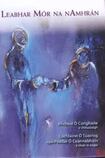
Leabhar Mór na nAmhrán translates as The Big Book of Songs, but it might as well be The Bumper Book of Sean-Nós for its generous content, reasonable price and no-nonsense approach. Here are 400 song texts, printed alphabetically and richly annotated, with lots of photographs of singers, many of them competition winners at Oireachtas na nGael. No music is included – probably just as well, given how big the book already is – but all the versions printed here are available on commercial sound recordings.
Unaccompanied singing in Irish has a lot in common with the blues, so it’s not surprising that the immediacy of its down-home origins translates so gracefully to world media, especially for individual listening.
Cló Iar-Chonnacht, in Inverin, Co Galway, offers CDs and downloads that include new compositions as well as recordings of singers from the past. They began to issue sean-nós recordings on cassette in 1987, when vinyl had all but disappeared and CDs were still in their early days. Gael Linn produced gramophone records from the 1950s, but the relatively low cost of cassette players, and their presence in cars, made it easy for singers to listen to the same song again and again until they knew it. Previously, if your family or near neighbours didn’t sing these songs, you had precious little chance of learning them (though some did manage).
Purists may object that multiple replays of the same recording lack the organic variation that is a fundamental to live performance, and some may complain that regional and local differences disappear when songs become portable, but, as with blues or jazz, devotees know the difference between recorded and live performances.
Flourishing tradition
Numerous organisations now offer classes and workshops in sean-nós for adults and children, in Gaeltacht areas and in cities, not just in Ireland. Joe Heaney spent his last years as an artist-in-residence at the University of Washington in Seattle, and some Irish universities now employ traditional singers. Sean nós has certainly changed, but the wonder is that it is flourishing, when it could so easily have died, and that its unique blend of poetry and music lives on.
There’s something heroic about sean-nós. It’s a solo performance, often with eyes closed, for an audience that wills the singer to give it everything, and make it to the finish, often with shouts or murmurs of encouragement. Singers train like athletes: if you learn one song and venture to perform it you may be heard politely, but real listening is kept for singers who have themselves listened carefully, and built a thoughtful repertoire.
Real singers choose songs for their meaning and history as much as for their melody, and perform them in public only when they have made them their own. Not all the songs are sad, of course, or demand serious emotional stamina, but the best of them can be a kind of therapy, transporting singer and listeners far from their surroundings into times of intense love or loss, to generations-old memories of drownings and hangings, or to the back-breaking grind of heavy physical work, while the singing itself sounds a message of connection, endurance and coming through. All the feelings that the Irish are renowned for not expressing find voice in these songs, but so do wit, mockery and sentimentality, and commentary on sport, politics, history and much besides.
Some of these songs have been around for hundreds of years, appearing as poems in school anthologies and known far beyond their home places, while others are still being sung by their makers. The tragic love song Una Bhán originated in Co Roscommon in the 17th century, while Éamonn an Chnoic commemorates a man outlawed in Co Tipperary, in 1702; Carraig Aonair preserves a father's grief on the drowning off the Fastnet Rock of his three sons and his daughter's husband, 80 or 90 years later.
Songs composed over the past century or so in response to important events and unusual circumstances offer a "history from below" in poetry and music. Many of their titles begin with the word "Amhrán", so Amhrán na Mianach (The Song About Mines), as sung by the late Maidhc Dainín Ó Sé, was composed before 1918 in Butte, Montana, by Seán Ruiséal, from Corca Dhuibhne; two brothers called Ferriter from the same area are said to have helped him, and to have died later in the copper mines there.
Veail Bheairtle Ó Donnchú's Amhrán Khildare is more labour history: a first-hand account from Connemara of the Wartime Emergency Scheme, which supplied Dublin with hand-cut turf during World War II, while the stunning Amhrán Pheter Mhicil Báille dates from the 1960s. Peter Báille (Bailey), a father of five children, transported goods between Leitir Móir and the Aran Islands in his sailing hooker until bottled gas made turf less essential for cooking and heating in Aran.
When he composed this personal testament about his wife’s death, at 33, and his fears for his own life he was working as a casual labourer in Kent. (He died in 1969.) His housemate wrote down the song as Báille composed it, and passed it to the celebrated singer Nan Ghriallais, who made it known through her performances.
Micheál Ó Conghaile, who founded Cló Iar-Chonnacht in 1985, has won awards for his mould-breaking fiction. He selected these 400 songs, most of them from his own company’s back catalogue, and wrote the thoughtful introduction.
For careful checking of transcriptions and preparing of texts and notes, he enlisted Lochlainn Ó Tuairisg, a CIC editor who is an expert on the older songs and their contexts, and Peadar Ó Ceannabháin, a powerful singer who is also a university lecturer on the oral literature of his native Connemara.
Given this line-up, and the prominence of Connemara in sean-nós singing, it’s unsurprising that most of the songs come from there; other areas are represented too, however, and a further 30 or so singers and scholars from various parts of Ireland have contributed notes. These average 200-300 words, though a few are much longer; some are dense with comparative and historical detail, others more personal or local. Taken together, they add immeasurably to the song texts.
Many of the singers transcribed are still going strong; others have passed away, as have some of the commentators, their loss still deeply felt. The last of the photographs shows a smiling Ciarán Ó Con Cheanainn, at 27 the youngest winner of Corn Uí Riada, at Oireachtas 2008, months before his untimely death. He has been honoured posthumously with the publication of his Clár Amhrán Mhaigh Cuilinn (2011), and with University College Dublin's award of a PhD for his almost-completed doctoral work, but this book commemorates him as singer and lover of songs. He was to have been one of its editors, and his signature appears on some 30 notes on songs.












